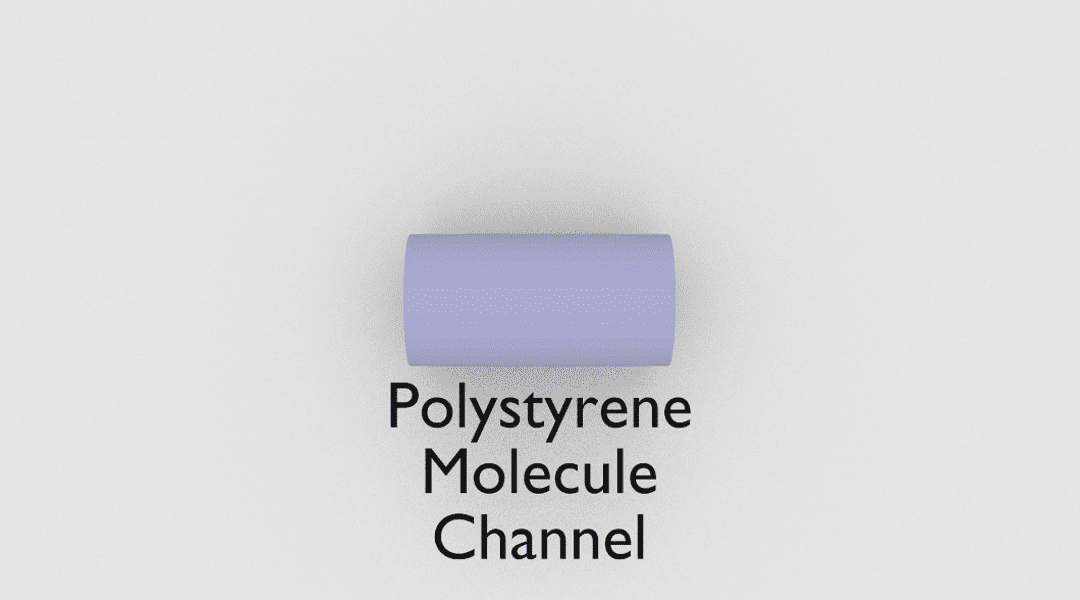
Illustration 9.1: Polystyrene Molecule Channel Full Size
Currently most Circuits use Electricity instead of Light as an Energy source, and Fiber-optics is only converting Electricity into Light, and back again, so Light Circuits only use Light as an Energy Source.
If you manufacture a silica or glass circuit that has channels that are just big enough for one Polystyrene Molecule to fit into, such that the Molecules Static Charge prevents it from physically coming into contact with the channel, a Light source can be used to move the Molecule, so you need one channel for the Molecule and another channel that is to small for the Molecule to move into, so it can read the state without changing it, as such you only need a path or channel that sits to both sides of the Molecule, one to set it to an on position and the other to set it to an off position, thus making one Light Gate.
Light Gates are comprised of two channels, I used the term Channel, when the properties is similar to fiber-optic, only smaller, one channel is large enough that only one Polystyrene Molecule can fit into it in a way that its Static Charge prevents if from coming into contact with the channel, the other channel is just small enough that Light can pass through, but not the Molecule, and its Static Charge prevents if from moving, as such the Gate forms a cross road for the path of Light traveling through it.
Identifying the parts of the Circuit, we have the Polystyrene Molecule Channel as seen in: Illustration 9.1: Polystyrene Molecule Channel, note that I will add features and names so look for changes in previous illustrations.
The Polystyrene Molecule Channel is like a Fiber-optic cable in the way Light moves through it, the Polystyrene Molecule has a static charge that prevents the molecule from coming into contact with the channel, so it can move without friction.
The Set Channel is also like a Fiber-optic cable, it feeds Light to the Set on or Set off channel as seen in: Illustration 9.2: Set Channel.
The Read Channel seen in: Illustration 9.3: Read Channel is also like a Fiber-optic cable, to read the state of the Gate, Light will pass through the Read Channel, if the Polystyrene Molecule is blocking the channel, it is in the Off State, if the channel is not blocked it is in the On State.
The Polystyrene Molecule as seen in: Illustration 9.4: Polystyrene Molecule is inside the Polystyrene Molecule Channel, as stated it has a static charge that prevents it from physically contacting the channel itself.
Setting the Gate State to Off as seen in: Illustration 9.5: Setting the Gate State to Off is accomplished by applying Light to the Set Channel Off, and removing Light from the Set Channel On, to read the State you apply Light to the Read Channel, the Polystyrene Molecule blocks the passage.
Setting the Gate State to On is accomplished by applying Light to the Set Channel On, and turning the Light off on the Set Channel Off, now the Light can pass through the Read Channel, note that Light can also flow from the Set Channel on to the Read Channel, since the channel is getting Light from two sources in this State. See Illustration 9.6: Setting Gate State to On.
The Logic Gate Symbol as seen in: Illustration 9.7: Logic Gate Symbol shows that the input for A and B can never be the same, you have to turn one on and the other off, so it will take many gates to create a Binary State Gate like: AND, NAND, OR, NOR, XOR, XNOR, NOT, or other types of Gates including Trinary Gate Logic, which has 3 States instead of 2 States like Binary Gates, this is useful for Fuzzy Logic, or determining if a gate has been set.
It should be clear from the illustration that the State of A and B act like a push-pull circuit, the lack of Light on one side and the presents of it on the other side is what moves the Polystyrene Molecule to the correct position.
My guess is that the Polystyrene Molecule will need a very strong Electromagnetic Force to change its State, the Light should hold the State in place, so the Light must be constant to hold the State in the On or Off position, as such, I would theorize that it would be immune to an Electromagnetic Pulse AKA EMP, making it idea for Space travel, where its likely to encounter strong Electromagnetic Fields.